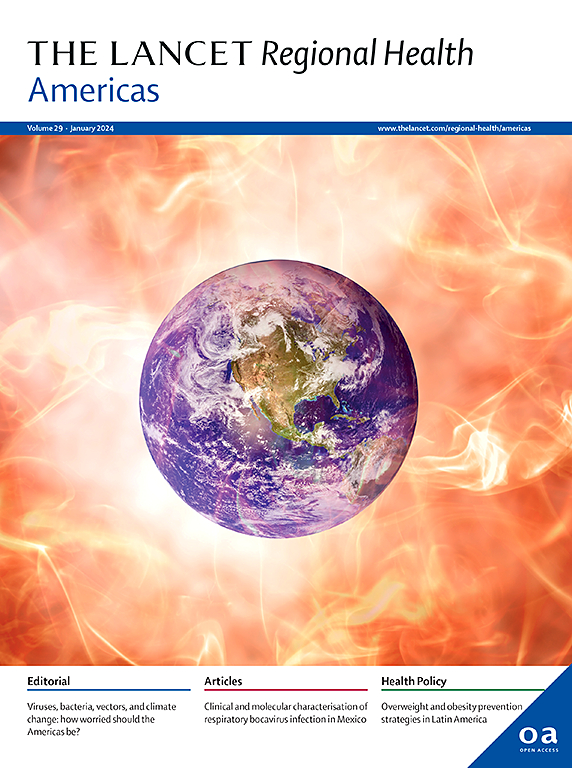巴西城市心血管疾病死亡率:2000-2018年全球疾病负担研究估计数
IF 7
Q1 HEALTH CARE SCIENCES & SERVICES
引用次数: 0
摘要
背景:在过去的几十年里,由于对危险因素的更好控制和获得医疗保健,巴西心血管疾病(CVD)的年龄标准化死亡率(ASMR)有所下降。然而,这种减少是如何在全国各城市分布的尚不清楚。我们的目的是利用全球疾病负担(GBD)研究的估计值评估2000年至2018年巴西各城市心血管疾病死亡率的变化。在这项生态研究中,使用GBD方法估算了巴西5个地区5564个城市在2000-2002年、2009-2011年、2016-2018年三年期间CVD的ASMR。应用视觉空间分析和Moran Local分析在ASMR中创建聚类。各市按人口规模分为3万、3 - 30万和30万。计算2000-2002年至2016-2018年ASMR变化百分比。研究发现,2000-2002年,除南方地区外,所有地区较发达地区和较大城市的心血管疾病ASMR较高。2016-2018年,北方最不发达地区的心血管疾病ASMR有所增加。在所有5个地区,心血管疾病ASMR的减少百分比在小城市比大城市更低,从北部小城市的- 3%到南部大城市的- 43%不等。在巴西,来自最脆弱地区和人口较少的城市,心血管疾病死亡率的降低程度较低。必须将适合这些较小城市,特别是最不发达地区的公共政策视为优先事项。巴西卫生部[赠款148/2018]和泛美卫生组织[协议函SCON2021-00288]。本文章由计算机程序翻译,如有差异,请以英文原文为准。
Cardiovascular diseases mortality in Brazilian municipalities: estimates from the Global Burden of Disease study, 2000–2018
Background
Age-standardized mortality rates (ASMR) for cardiovascular diseases (CVD) have decreased in Brazil in the last decades due to better control of risk factors and access to healthcare. However, how this reduction is distributed across the country's municipalities is unknown. We aimed to evaluate changes in CVD mortality rates across Brazilian municipalities from 2000 to 2018 using estimates from the Global Burden of Disease (GBD) study.
Methods
In this ecological study, ASMR for CVD were estimated using GBD methodology for 5564 Brazilian municipalities from 5 regions in the triennials: 2000–2002, 2009–2011, 2016–2018. A visuospatial analysis was applied to create clusters in ASMR with Moran Local analysis. Municipalities were stratified by population size in <30,000, 30,000–300,000, and >300,000 inhabitants per region. The % changes in ASMR from 2000–2002 to 2016–2018 were calculated.
Findings
In 2000–2002, ASMR for CVD were higher in more developed regions and in larger municipalities of all regions, except for the South. In 2016–2018, CVD ASMR increased in the least developed Northern regions. The % reduction in CVD ASMR was lower in small vs large municipalities within all 5 regions, varying from −3% in small Northern municipalities to −43% in large Southern municipalities.
Interpretation
The reduction in CVD mortality in Brazil was lower in municipalities from the most vulnerable regions and smaller populations. Public policies tailored to these smaller municipalities, particularly on the least developed regions, must be considered a priority.
Funding
Brazilian Ministry of Health [grant 148/2018] and Pan American Health Organization [Letter of Agreement SCON2021-00288].
求助全文
通过发布文献求助,成功后即可免费获取论文全文。
去求助
来源期刊

Lancet Regional Health-Americas
Multiple-
CiteScore
8.00
自引率
0.00%
发文量
0
期刊介绍:
The Lancet Regional Health – Americas, an open-access journal, contributes to The Lancet's global initiative by focusing on health-care quality and access in the Americas. It aims to advance clinical practice and health policy in the region, promoting better health outcomes. The journal publishes high-quality original research advocating change or shedding light on clinical practice and health policy. It welcomes submissions on various regional health topics, including infectious diseases, non-communicable diseases, child and adolescent health, maternal and reproductive health, emergency care, health policy, and health equity.
 求助内容:
求助内容: 应助结果提醒方式:
应助结果提醒方式:


